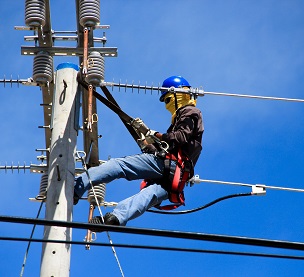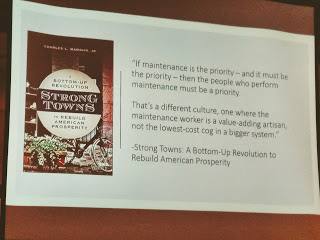Maintainers III: Infrastructure and climate
Posted on 15 November 2019
Maintainers III: Infrastructure and climate
 Photo by fran hogan on Unsplash
Photo by fran hogan on UnsplashBy Dr Laura James, Software Sustainability Institute Fellow
This blog post was first published on Dr Laura James's own blog on 11 November 2019.
Maintainers III started with a joint keynote. Taeyoon Choi spoke eloquently about many topics. Much of his talk discussed technology, which I'll cover in a separate post.
Taeyoon quoted a great talk by Nabil Hassein in 2018, on computing, climate and all our relationships - definitely worth looking up. He proposed that we needed a new frame for much of our work and thinking:
- distribution not decentralisation
- care instead of control
- information instead of data
How do you know when something is infrastructure? If there's someone on call at 3am to fix it when it breaks, it's infrastructure.
Things that are luxuries gradually become services you can pay for, which become utilities (which you can build systems on top of), and eventually something which is a right. For instance, GPS is becoming a utility; a recent US act makes electricity a right (for Americans, not having power is a political thing, which is why hurricanes taking out power is a big deal). But whether something is infrastructure or not depends on your point of view. Wifi in your apartment building seems like infrastructure to you; but from the building manager point of view, it's the cable that is the infrastructure.
Deb Chachra's keynote was a fascinating excursion through different forms of infrastructure, labour and maintenance, crafted with a sense of perspective as a child of migrant parents. Deb sometimes works in the Boston Athenæum, a library designed for people who do not look like her. Those who built the library would not have cooked their own dinners; now Deb can go home and cook hers in twenty minutes, because of all the infrastructure of water, gas, food supply. This is a reminder of Katrine Marçal's Who cooked Adam Smith's Dinner? - the answer being that he was able to do his work because his mother cooked and kept house. This sort of gendered labour is something we have less of, now that networks of infrastructure covering our continent mean we can turn on lights or heat at the flick of a switch, access prepared and preserved food near our homes, and so on. We are "a collective cyborg" dependent on far more than just a local reservoir or farm.
There's still an absence of fair wages for labour in the home, even if it is eased by infrastructural systems. America's infrastructure is not in good shape; the American Society of Civil Engineers report card gave it a D+ in 2017.
When systems fail, the gendered labour they replaced steps up to fill the gap. In Mexico city, where acquifers are overused and pipes undermaintained, water scarcity is now a way of life. The women in neighbourhoods without water are the ones who end up staying home, arranging water truck deliveries, and taking to the streets to block roads to force the water trucks to stop when needed. Water is expensive, but still cheaper than medicine - and sickness is the result of inadequate water.
Deb went on to talk about water treatment in different contexts. In an American water processing plant, one might find ten stages of processing - Deb showed a photo of sampling taps, with fluffy toy microbes hanging nearby. Testing the water every day to ensure quality is a sacred trust, requiring constant labour. Compare with regions in Syria, where public health systems are degraded, first by not paying water and sewer workers, then by intentional disruption such as blocking delivery of chlorine.
"Any sufficiently advanced neglect is indistinguishable from malice." Maintenance is not just about maintaining the status quo, especially when the status quo is changing, for instance with climate change.
We move food, water, fuel vast distances across the land, using systems built for the long term. They may be fifty or over a hundred years old - and were constructed assuming a stable ecology (and stable governance). Perhaps we do not have these things now. Deb gave examples of recent Texas floods, where water treatment facilities were overwhelmed despite good maintenance, because of additional sediments; and the camp fire in California. Our collective infrastructure needs to be both maintained and resilient in the face of climate change.
Climate change is also a causal factor. The energy footprint of our infrastructure is around 40% of the energy we use. We substitute energy for other forms of labour - for instance, water and electricity mean you can do laundry. But this isn't sustainable energy today.
There's another way in which this is not sustainable - inequality. Consider history, as shown in Downton Abbey, where a large number of servants are responsible for keeping the house running, at least until the transition from aristocracy to modernity in the first half of the twentieth century (we see a servant given an electric toaster, showing the future technology arriving). This made sense to the people living in the castle, they could justify the way things were and the labour needed to serve them, but there is nothing you could say to a serf to make it seem fair. We do not have control over the circumstances of our births. Deb was born into an infrastructural birthright in the US which her parents were not. A century ago, she would not have been born into infrastructural aristocracy.
How do we make the infrastructural privilege - which replaces the labour otherwise necessary - available to everyone in the world?
There aren't enough fossil fuels to support this for everyone; there is enough renewable energy, but we need equitable access to it globally. Equitable infrastructure is not just who does the maintenance, or who deals with the lack of maintenance in the past; it's how do we make our lives equitable.
Our collective infrastructure needs to be maintained, sustainable, equitable, resilient - interlocking factors.
Another keynote about infrastructure came from Chuck Marohn, author of Strong Towns. Whilst his book has an American focus, the ideas he covered seemed fairly universal to "developed" economies.
Chuck started with an example of a residential cul-de-sac road being resurfaced. The cost of this work would take the city 37 years to recoup via tax from adjoining property, and the road surface would have long since worn out. As it's a dead end, there's no through or commercial traffic so the only beneficiaries of the works are the homes on the street.
(This was a familiar narrative from Indy Johar's work - he touched on this in his intense talk at the 2019 Festival of Maintenance - you can find the event write-up here or watch on YouTube.)
The developer who originally built the homes also laid the road, and then turned it over to the city to maintain. Local taxes were meant to pay for this maintenance, but don't, because the level is too low. You'd need 46% more property taxes to cover the cost of resurfacing at the frequency needed - and that's without other costs.
Chuck moved on to a similar example of a business park, where the city also offered tax inducements to get businesses to move in, and would never recoup through commercial taxation. There are also land uses that don't pay tax - for instance churches or a school bus yard.
He described this as "the growth ponzi scheme". You get a little bit of tax each year, and it looks like it adds up to a lot of money over time. But every 25 years or so you have to spend it all - and a little bit more - redoing all the infrastructure. When you add up all the various projects the upward curve graph just doesn't work any more.
 Slide from Chuck's talk with quotes from Strong Towns
Slide from Chuck's talk with quotes from Strong TownsAfter the terrible times of the depression and the second World War, America created a kinetic growth machine by duplicating an efficient, centralised pattern. Unfortunately we all discount the negative ramifications which come in the future - it's a human flaw. We build as if the things we create, once finished, will be magically maintained forever. Our ancestors did not - they built incrementally. You can see this in many cities around the world - starting with some huts, then growth. The early row of small pop-up shacks becomes Main Street. If some of the popups failed, it didn't matter; each was a small bet, the whole city would probably survive. As people gather, land becomes valuable, and there is intense pressure to grow up, and out.
Chuck moved on to an example of two adjacent blocks which were jumped over by post-war growth. One block was still basically small shacks; another tore down what were considered slums, and built a taco drive-through. This looks like growth, a positive thing. However, over time the small businesses change, but there's still a range of small operations. The taco joint is now neglected, and on a journey to become - as this is America - probably a used car lot, and then eventually a derelict site (which a developer will request a tax subsidy to build on). And yet the taco block is worth only $600k now, despite all the public infrastructure which enables it; the 'blighted' block of run-down businesses has a total value of $1.1m. The old stuff, after a century of neglect, is outperforming the recent shiny new building.
Our maintenance history is about defaulting on our promises; the promises were always unreasonable.
We have to change this, own the promises together, and not outsource it all.
So why do American cities go broke? You can see this by looking at maps, and trying to identify which blocks generate more in tax than in outgoing cost. You might think the poor areas aren't generating much tax, but they also are not costing a lot - the infrastructure is run down, there are not vast subsidies being paid out. The city may also be neglecting them too, as these are probably not the "squeaky wheel" areas where people complain and get things repaired. The areas of fancy box stores and malls, of suburban homes with three-car garages in cul-de-sacs, are were the city is spending more money. Older areas are more resilient, flexible, and strong. We are building inflexible, brittle systems now.
How can this be changed? One option would be to raise taxes. But you would have to multiply them five times over, just to maintain what we have, without any additional growth. You can't tax people that much. State funds and bond issues are not good ways to pay for maintenance - these things would never be voted in. So ultimately, America cannot pay for everything everywhere, and that means some places will have to be allowed to go, so others can be maintained.
Detroit is already along this path. Everyone thinks their city could never fail as Detroit has, but Detroit was wealthy and fancy too not that long ago. They pioneered commuter suburbs, ran highways, made big parking lots - all new ideas, and the city did comparatively well in the depression. But bankruptcy happens slowly, then all at once. Detroit is just a little bit ahead of other cities, now.
Chuck's book, Strong Towns, calls for a celebration of maintenance. Maintenance like in Disney theme parks, where ongoing basic care is recognised as essential, and there is obsessive attention to detail even in the repair of potholes, say. The people who perform maintenance should be a priority.
Growth solved the great depression, but today's problems are different. We must shift from growth to stability; from newness to maintenance; and squeeze value from what we have already. This is the maintenance mindset.
Stewart Brand spoke of how artists go to poor areas and then they gentrify. He asked Chuck whether graceful degradation of areas that cannot be maintained might support creative communities. Is there a way to let areas go, so they don't die, but become cheap yet functional for artists? Chuck felt this might work in the big cities with access to incredible amounts of capital (such as San Francisco or Oakland). It works if the wealth created brings people along with it. But in small cities, without so much money, such as Lafayette, this probably doesn't work. New cities used to be started by the poor, and it was a way to get a leg up - setting up the small business in what becomes Main Street. Over time, these cities ended up with wealthy people in the city and the poor at the edge. Now, though, cities have poor people in the middle, and wealth in the suburbs. In dense poor communities, you can walk to a food store, take a bus to a job, form community bonds and resilience. In a suburb, you lose all this, and suburban poor are condemned to a dreadful life. If you don't have a car, you can't walk. So, Chuck feels like the unmaintained areas cannot really gracefully decline; some places will have to not have services. Instead we must find ways to welcome new people to the spaces which remain, which are maintained.
Many diverse talks at Maintainers III ended up asking questions like this - what does the transition look like from now, to some more limited future, where we will need resilience and sustainability, and who will be affected in what ways by these transitions?

